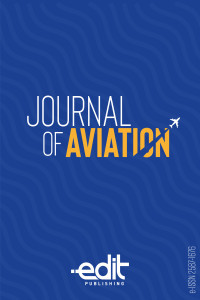Balistik Mühimmat Menzillerinin Hızlandırıcı Fırlatıcı Konsepti Kullanılarak Uzatılmasının Analizi
Bu çalışmada, eski balistik mühimmatları ateşlemeden önce hızlandırarak menzillerini uzatmayı amaçlayan yeni bir fırlatıcı konseptinin uygulanabilirliği detaylı olarak incelenmiştir. Yeni fırlatıcı konseptinin verimliliğini analiz etmek amacıyla ModeFrontier yazılımında Çok Amaçlı Genetik Algoritma Yöntemi kullanılarak çok değişkenli ve tek değişkenli optimizasyon çalışmaları yürütülmüştür. Fırlatma açısı, mühimmatın fırlatıcıdan çıkış hızı ve mühimmatın fırlatıcıdan çıkma anı ile ateşlenmesi arasında geçen süre tasarım değişkenleri olarak belirlenmiştir. Mühimmatın iki boyutlu yörünge çözümünü gerçekleştirmek amacıyla bir MATLAB kodu hazırlanmış ve doğrulanmıştır. Optimizasyon süreçleri sonucunda, her bir tasarım değişkeninin mühimmatın menzili üzerindeki etkisini incelemek; klasik fırlatıcılar ve yeni nesil hızlandırıcı fırlatıcılardan fırlatılan mühimmatların uçuş yörüngeleri arasında kıyaslama yapmak amacıyla grafiksel sonuçlar hazırlanmıştır. Hızlandırıcı fırlatıcı konseptinin kullanılmasının, bu araştırmada incelenen jenerik mühimmat için klasik fırlatıcıya göre yaklaşık %20 menzil artışı sağladığı sonucuna varılmıştır. Bu yeni konsept, farklı balistik mühimmat türlerine kolayca uyarlanabileceğinden ve bu tür bir fırlatıcı geliştirme sürecinin maliyeti, yeni mühimmat geliştirmek için gereken maliyetten daha az olacağından, elektromanyetik hızlandırıcılar veya mancınık gibi hızlandırıcı fırlatıcıların yakın gelecekte geliştirilmesi mantıklıdır.
Anahtar Kelimeler:
Menzil Optimizasyonu, Hızlandırıcı Fırlatıcı Konsepti, 2-B Yörünge Çözücü, ModeFrontier
Analysis of Range Extension Process for Outdated Ballistic Munitions Ejected from an Accelerator Launcher Concept
In this study, the feasibility of a new launcher concept that provides range extension for outdated ballistic munitions by speeding up them before their ignition is examined in detail. To analyze the efficiency of the new concept, multi-variable and single-variable optimization processes are conducted using the Multi-Objective Genetic Algorithm Method in the ModeFrontier environment. Launch angle, ejection velocity of the munition from the launcher, and ignition delay of the rocket motor after the ejection process are determined as design variables. An in-house MATLAB script is prepared and validated to perform numerical solutions of the munition’s two-dimensional trajectory. As a result of the optimization processes, graphical results are prepared to examine the effects of each design variable on munition’s range and to make a comparison between the flight trajectories of the munitions which are launched from classical and accelerator launchers. It is concluded that usage of the accelerator launcher concept provides approximately 20% range extension for the generic munition examined in this research when compared to the classical launcher. Since this new concept can easily be adapted to different types of outdated ballistic munitions and the cost of the accelerator launcher development process will probably less than the cost required to develop new munitions, it will be reasonable to develop accelerator launchers such as electromagnetic accelerators or catapult launchers in near future.
___
- Y. R. Yang, S. K. Jung, T. H. Cho, and R. S. Myong, “Aerodynamic shape optimization system of a canard-controlled missile using trajectory-dependent aerodynamic coefficients,” Journal of Spacecraft and Rockets, 49, 243–249, 2012.
- O. Tanrikulu, and V. Ercan, “Optimal external configuration design of unguided missiles,” Journal of Spacecraft and Rockets, 35, 312–316, 1998.
- Y. Li, N. Cui, and S. Rong, “Trajectory optimization for hypersonic boost-glide missile considering aeroheating,” Aircraft Engineering and Aerospace Technology: An International Journal, 81, 3–13, 2009.
- B. D. Özdil, “Trajectory Optimization of a Tactical Missile by using Genetic Algorithm,” Middle East Technical University Graduate School of Natural and Applied Sciences, M.Sc. Thesis, 2018.
- J. D. Vasile, J. T. Bryson, and F. E. Fresconi, Aerodynamic Design Optimization of Long Range Projectiles using Missile DATCOM: AIAA SciTech 2020 Forum, January 06-10, 2020, Orlando, ABD.
- A. J. Pue, R. J. Hildebrand, D. E. Clemens, J. R. Gottlieb, J. M. Bielefeld, and T. C. Miller, “Missile concept optimization for ballistic missile defense,” Johns Hopkins Apl. Technical Digest, 32, 774–786, 2014.
- A. Sumnu, I. H. Guzelbey, and O. Ogucu, “Aerodynamic shape optimization of a missile using a multiobjective genetic algorithm,” International Journal of Aerospace Engineering, 2020, 1–17, 2020.
- J. Zhou, and T. Liu, “Physical analysis and optimization of electromagnetic coilgun launch systems,” American Journal of Physics, 87, 894–900, 2019.
- S. J. Lee, L. Kulinsky, B. Park, S. H. Lee, and J. H. Kim, “Design optimization of coil gun to improve muzzle velocity,” Journal of Vibroengineering, 17, 554–561, 2015.
- S. J. Lee, J. H. Kim, B. S. Song, and J. H. Kim, “Coil gun electromagnetic launcher (EML) system with multi-stage electromagnetic coils,” Journal of Magnetics, 18, 481–486, 2013.
- J. Shen, S. Fan, Y. Ji, Q. Zu, and J. Duan, “Aerodynamics analysis of a hypersonic electromagnetic gun launched projectile,” Defence Technology, 16, 753–761, 2020.
- A. M. Nathan, “The effect of spin on the flight of a baseball,” American Journal of Physics, 76, 119–124, 2008.
- R. K. Adair, The Physics of Baseball. New York, ABD: Perennial, 2002.
- Yayın Aralığı: Yılda 3 Sayı
- Başlangıç: 2017
- Yayıncı: Vedat Veli ÇAY
Sayıdaki Diğer Makaleler
Balistik Mühimmat Menzillerinin Hızlandırıcı Fırlatıcı Konsepti Kullanılarak Uzatılmasının Analizi
Ceyhun TOLA, Pınar BEYAZPINAR, Deniz AKIN
Kar Payı Ödeme Politikalarının Belirleyicileri: Havayolu Sektöründen Kanıtlar
Stresin İş Tatmini Üzerine Etkisi: Pilotlar Üzerine Bir Araştırma
Gaz Türbini Yanma Odası Astarında Efüzyon Soğutmanın Sayısal Olarak İncelenmesi
Passengers' Shopping Preferences: A Study of Istanbul Airports
